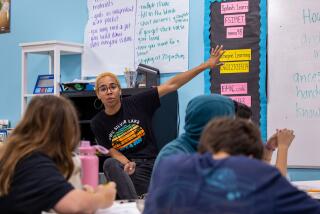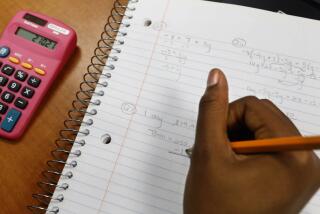Statistically Speaking : High School Teacher Promotes Quantitative Literacy
- Share via
“You can teach people to be as comfortable with numbers as they are with words,” Gretchen Davis said with passionate conviction.
Davis, 46, who was chosen outstanding teacher of 1985-86 by the Santa Monica-Malibu Unified School District, is in the forefront of a significant new thrust in American education.
For the record:
12:00 a.m. May 29, 1986 For the Record
Los Angeles Times Thursday May 29, 1986 Home Edition Westside Part 9 Page 3 Column 2 Zones Desk 1 inches; 34 words Type of Material: Correction
Because of an editing error, a story appearing Sunday on Santa Monica High School teacher Gretchen Davis mistakenly said that the median or mode grades of a hypothetical student with four Bs and an F would be a B-. In fact, the grade would be a B.
Just as school watchers once worried that Johnny can’t read, many of today’s educational critics fear that Johnny can’t think--at least about numbers.
Davis is one of a cadre of pioneering teachers throughout the country who are doing something to change that. Their aim is to promote what they call quantitative literacy.
Urgent Need for Courses
Algebra, trigonometry and other traditional math courses all have a place in the curriculum, Davis and like-minded educators say. But there also is an urgent need for new courses that will prepare students to interpret graphs, calculate odds, scrutinize opinion polls and generally make better sense of the quantitative information in their lives.
In her Santa Monica High School classroom, Davis is helping create that new curriculum. She is developing course work for high school students, including those who are not notably gifted in math, in the practical but rarely taught areas of statistics and probability.
She also is teaching other teachers, some untrained in mathematics but forced to teach it because of the shortage of trained math instructors. (The Los Angeles Unified School District alone projects a shortage of 250 mathematics teachers for the coming year.)
Traditionally thought to be too tough for pre-college students, statistics and probability usually have been reserved for the college curriculum, where they often separate the future social scientists from the English majors.
Taught in Kindergarten
But Davis is convinced that statistics and probability can, and must, be taught in high school. For that matter, she thinks they can, and should, be taught in kindergarten, a viewshared by California education officials in their most recent guidelines for mathematics in the public schools.
As Davis explained, an understanding of the fundamentals of statistics and probability is not an intellectual luxury. It is a basic survival skill that everyone, not just the college-bound
student, needs to function well in a high-tech society.
“We live in a world that’s bombarded by numbers,” Davis said. “If we don’t have citizens who can be intelligent about the use and abuse of those numbers, we’re in trouble.”
Unorthodox Aids Used
To demystify statistics for her students, Davis uses thumbtacks, chocolate-chip cookies and other unorthodox classroom aids. Although such hands-on demonstrations are more typical of elementary than secondary school, Davis finds them effective in commanding the attention of those students who do not automatically admire the elegance of statistical theory.
In teaching probability, or the mathematics of likelihood, for example, Davis eschews the lifeless word problems that are the mainstay of most textbooks. Instead, she and her students go through bag after bag of M & Ms, determining the probability of getting an orange candy by first shaking one M & M after another out of the packs and counting them.
Using this down-to-earth method, a recent class calculated that the odds of an orange were about one in five. Their finding jibed with the manufacturer’s disclosure that 20% of the little candies that melt in your mouth, not in your hand, are orange-colored.
Instead of assigning ho-hum, ready-made data sets, Davis has her students collect their own data on whatever subject interests them.
Sports Applications
“At this age, it’s food, records, movies, cars and sports,” she said of the preoccupations of her juniors and seniors. Thus, one student did a statistical analysis of the performance, year by year, of a favorite ice-hockey player and another analyzed the price of ice cream cones from various outlets on the Westside.
A de-emphasis of formulas and theory is typical of the new statistics, according to Ann Watkins, who is on the mathematics faculty at Los Angeles Pierce College in Woodland Hills.
“Nowadays we’re taking a much more informal approach,” she said. “We’re teaching something called data analysis to a greater degree. What that is is organizing data so you can see any patterns in it.”
Watkins, who serves on a joint curriculum-development committee of the American Statistical Assn. and the National Council of Teachers of Mathematics, described the Santa Monica teacher as both contagiously enthusiastic and mathematically smart.
Getting Their Attention
Watkins also lauded Davis’ ability to involve her students.
“The idea in math is to do anything you can to get their attention,” Watkins said. Davis is especially good at that, said Watkins, who finds that her own, older students pay especially close attention when the lesson is probability as it applies to the reliability of contraceptives.
After the students collect their data but before they do any computations, Davis makes the young statisticians simply look at what they have.
“Explore the data. See what the data tells you,” she instructs them. Often, the students find, the data says surprising things.
This semester, for example, 17-year-old Pomona Valero, a cinema buff, decided to find out how old the Oscar-winning best actors and actresses were at the time of the award. Valero had not expected to discover much of anything from the data, she said. But when she entered the ages of each of the men on one side of a simple graph called a stem-leaf plot and the ages of all the women on the other side, she saw instantly that the actors were significantly older than the actresses.
Disparity Became Clear
Valero could see the nine-year disparity even before she calculated the average ages of male and female winners. (The mean age of the men was 43.31 years, of the women, 34.24).
When students draw a conclusion from such an analysis--say, that Oscars tend to go to young women and older men (no man under 30 has won a Best Actor Oscar)--they do so with demonstrable authority.
“It’s very clear, very concrete,” Davis said of Valero’s revealing graph. “You can’t argue with it.” Unlike those educators who think calculators and computers are an insidious threat to the minds of growing children, Davis encourages her students to use the machines whenever possible.
“There’s no reason for a student to do tedious calculations when what’s really important is analyzing the data,” she said. Students also use computers to simulate experiments that they could do only with great difficulty otherwise.
Throwing Thumbtacks
Since the principles of statistics and probability emerge over time, or after many, many repetitions of coin tossing or whatever activity is under study, the computer is invaluable in the classroom, Davis said. Her students turn to the computer, for example, to “throw” electronic thumbtacks time after time in determining the probability that they will land with their points up.
As Davis explained, “It is very tedious to throw thumbtacks a thousand times. It’s tedious to do it 20 times. But the computer doesn’t get tired.”
Davis, who has taught at Santa Monica High for 17 years, said that her first statistics class in college permanently changed the way she saw the world. It gave her a tool for thinking about quantitative information that she simply had not had before. She said that she constantly uses the statistical techniques she is now teaching in making real-life decisions.
In grading, for example. If a student has four Bs and an F on his tests, most teachers will determine his average grade by adding together the numerical values of the test scores and dividing by the number of tests. The resulting average, called the mean in statistics, would be a C or C+.
Median Grade Used
But because Davis knows her statistics, she knows that the mean is very sensitive to an extreme grade. She always tries to give a student the grade that best reflects his or her performance. So instead of using the mean, she often calculates a student’s median grade (the grade in the middle when all the grades are ranked from high to low) or the mode grade (the grade that occurs most often).
Using either of these methods, the student who did badly on a single test would get a B- in Davis’ view, the mark he or she probably deserves.
Able to calculate accurately the probability of being a victim of a terrorist attack (minuscule), Davis does not hesitate to travel to Europe in spite of the headlines. Knowing the statistical tendency of events to regress toward the mean, she is not surprised when she gains weight after a diet.
Davis, who began her career teaching English and Latin, said she used to feel terribly isolated in her conviction that statistics belong in the classroom. But that is changing rapidly. In addition to Santa Monica High School, several other Southland high schools, including John F. Kennedy High School in Granada Hills, Mira Costa High School in Manhattan Beach, Beverly Hills High School and Westlake School for Girls in Beverly Hills, now offer units or courses in statistics and probability.
New ‘Framework’ for Math
Most encouraging of all, Davis said, is the state’s recent decision to make statistical thinking as integral a part of every Californian’s education as reading or writing.
California’s new “framework” for mathematics--the state Department of Education’s official guidelines for the math curriculums to be offered in public schools--urges that statistics and probability, as well as logic and other practical but traditionally neglected areas of mathematics, be taught at every grade level, from kindergarten through high school.
The Los Angeles Unified School District hopes to have textbooks that reflect the new guidelines in high school classrooms by this fall.
The new math curriculum will be introduced into elementary schools as soon as appropriate books can be obtained, perhaps by the fall of 1987, according to district staff.
As Davis talked, she smiled at the prospect of all those quantitatively literate little ones, reading numbers as they counted M & Ms.
More to Read
Sign up for Essential California
The most important California stories and recommendations in your inbox every morning.
You may occasionally receive promotional content from the Los Angeles Times.










